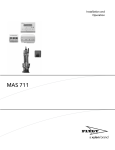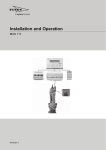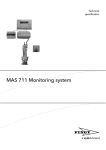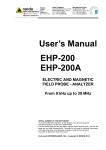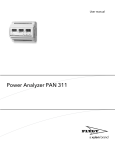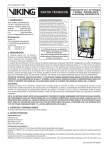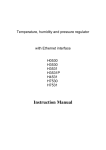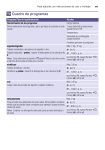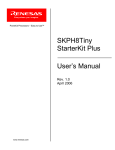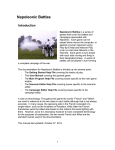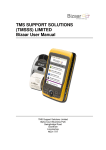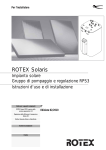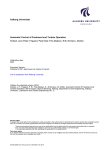Download Installation and User Manual
Transcript
Installation and User Manual MAS 711 Monitoring system 895115_08 MAS 711 - Installation and User Manual Contents 1. INTRODUCTION 4 2. INSTALLATION GUIDELINES AND SAFETY 5 Ingress protection Electromagnetic interference EX applications and operating conditions Startup Warranty 5 5 5 5 5 2.1 2.2 2.3 2.4 2.5 3. WIRING AND MOUNTING 3.1 3.2 3.3 3.4 3.5 3.6 3.6.1 3.6.2 3.6.3 3.6.4 3.6.5 3.6.6 3.7 3.8 3.9 3.9.1 3.9.2 3.9.3 4. 17 28 Indication Active alarms list Alarm and event log Event messages and suggested actions 28 28 28 28 30 Data bases of measurement results and other information Cyclic memory data base ‘Alarm log plot’ database Histograms WEB TOOL – INSTALLATION 7.1 7.2 7.3 7.3.1 7.3.2 7.3.3 7.3.4 6 6 7 8 8 9 9 9 9 9 10 12 14 14 15 15 15 15 17 18 18 18 19 22 DATA LOGGING 6.1 6.1.1 6.1.2 6.1.3 7. Menu system Display and keys, general Navigation help system Access code View - menu tree branch Setup - menu tree branch ALARM HANDLING 5.1 5.1.1 5.1.2 5.1.3 6. Base unit dimensions Operator panel dimensions Base unit wiring diagram, large pumps Base unit wiring diagram, midrange pumps Base unit indication Monitoring alternatives with Flygt pumps Flygt standard monitoring of large pumps (12-lead SubCab sensor cable) Optional monitoring, large pumps MAS-option for midrange series pumps Recommendation to measure pump current Sensor cable wiring, large pumps Sensor cable wiring, midrange pumps (3153, 3171, 3202, 3301) Operator panel and Pump memory wiring Setup/configuration/default settings Temperature measurement with Pt100 sensors Measurement error due to long leads Methods to compensate for error How to compensate for measurement error using MAS THE OPERATOR PANEL AND MENU SYSTEM 4.1 4.1.1 4.1.2 4.1.3 4.1.4 4.1.5 5. 6 30 30 30 30 31 General Installation of Java runtime module from Sun Connection of a computer for web page access IP addresses of a MAS Base unit Direct connection between a computer and MAS Base unit Connection to a Local Area Network (LAN) Modem connection between a computer and MAS Base unit 2(68) 31 32 32 32 33 35 36 MAS 711 - Installation and User Manual 8. WEB TOOL - SETUP 8.1 8.2 8.3 8.4 8.5 8.6 8.7 8.7.1 8.7.2 8.7.3 8.8 8.8.1 8.8.2 8.8.3 8.9 8.9.1 8.9.2 8.10 9. 10.1 10.2 10.3 10.4 10.5 11. 11.1 11.2 12. 12.1 12.2 12.3 13. 13.1 13.2 Manual setting of a monitoring channel Recording of running time and number of starts Unit information Alarm and Quick overview reload and update time Access levels and password setting Program update Backup and restoration of parameters Complete backup of all parameters Change and loading of a selection of parameters into the Base unit How to enter data plate text into the Base unit and Pump memory How to preserve and delete measurement data Preserving all data in a MAS Restoring measurement data and parameters Erasing all measurement data in a MAS Communication (RS-485, Modbus) Modbus communication Temporary use of the Operator panel – communication alarm disabling Pump info - Setup WEB TOOL - VIEW 9.1 9.2 9.2.1 9.2.2 9.2.3 9.2.4 9.2.5 9.3 9.4 10. 40 41 42 43 43 44 45 46 46 47 47 48 48 49 50 52 52 52 53 54 General Presentation of data Quick overview Trend diagrams Alarm log plot Running statistics Viewing monitoring channels Export of data Pump info - View 54 55 55 56 57 58 59 60 61 COMMUNICATIONS PORTS 62 Local (Modbus/RS-485) for Pump memory and Operator panel Ext 1 (Modbus/RS-485) for ‘Higher level system’ Ext 2 (Modbus/RS-485) for a Power Analyzer Ethernet RS-232 Modem communication PUMP MEMORY 62 62 62 62 62 63 Memory contents Pump memory syncronization and backup 63 63 POWER ANALYZER OPTION 64 Current measurement with current transformers (CTs) Wiring of PAN 311/ WM14 Enabling communication STEP BY STEP INSTALLATION USING THE WEB TOOL Step by step installation using the Web tool Step by step installation using the Operator panel 3(68) 64 64 65 66 66 67 MAS 711 - Installation and User Manual 1. Introduction MAS 711 (Monitoring and Status – hereafter called only MAS) is a monitoring system for Flygt pumps. Its main duty is to monitor and protect a pump and to record measurement results from sensors and measurement modules. If an abnormal condition occurs, MAS can stop the pump and send an alarm. Information about the alarm is stored in a database of recorded measurements, which enables the operator to analyze the sequence of events and carry out adequate actions. MAS contains an embedded web server, which means that it can be operated easily using a standard computer and a web browser. MAS has several ports for serial communication of measured data, alarms etc. This allows MAS to operate as a component in a supervisory control and data acquisition system (SCADA). The MAS-system consists of four components: • The Base unit contains a powerful processor, memory and terminals for sensor connections. • The Operator panel is a front panel mounted module used for interaction with the system. • The Pump memory is mounted inside the pump and contains information about the pump such as serial number, pump sensor configuration, measured data, etc. • The Power analyzer is an optional unit, which measures power, current, voltage and power factor. Measurement results are transferred to the Base unit. Fig. Overview of the MAS-system 4(68) MAS 711 - Installation and User Manual 2. Installation guidelines and safety Electrical work must only be carried out by a qualified electrician and in accordance with local regulations. During installation, all equipment must be disconnected from the power supply without any possibility of being made live. Relay output terminals (terminals: 27-32) may be connected to voltage supply up to 250 V. 2.1 Ingress protection The MAS Base unit ingress protection is 20, which means there is no protection against water. Therefore, it should be mounted inside an electrical cabinet. The Operator panel front has an ingress protection of 65, which means it withstands a water splash or jet if mounted in a panel or a cabinet door. The back of the Operator panel is IP20. 2.2 Electromagnetic interference When installing electronic measuring and control systems, it is important that the cabling is specified and run to minimize interference from electrical and magnetic fields. The many potential sources of interference include relay coils, solenoid valves, switches, variable frequency drives, earth (ground) currents and static discharges. Susceptility to interference also varies with the electrical environment i.e. to factors such as cable lengths, screening and the use of interference suppression. The risk of interference can be minimized by good planning. 2.3 EX applications and operating conditions The Base unit or Operator panel may not be installed in an explosive or flammable environment. Note that if the pump is installed in an explosive or flammable environment, the motor overheating protection function (Temp stator ph 1-3) by means of thermal contacts, must be setup to stop the pump, see section ‘Alarm handling’ (A-alarm). This must also be set to manual reset and not automatic. The ambient temperature should be between 0°C (32 °F) and 50°C (122 °F). Max humidity is 90% RH. 2.4 Startup The Base unit contains a microprocessor and requires approximately 40 seconds to boot and to upload parameters from the internal memory banks. The interlock relay (Go), which is used to stop the pump in case of failure, does not close to allow pump operation until the Base unit has completed booting. Note! In the event of a power outage exceeding 50 ms, the Base unit will re-boot, making the pump inoperable for 40 s. Therefore, in the case where an automatic standby power generator is used to maintain pump operation during supply grid outages, it is worth considering connecting the MAS Base unit to a UPS (uninterruptible power supply). 2.5 Warranty Flygt undertakes to remedy faults in products sold by Flygt provided: • that the fault is due to defects in design, materials or workmanship • that the fault is reported to Flygt or Flygt’s representative during the warranty period • that the product is used under conditions described in the Installation manual and in applications for which it is intended • that the monitoring equipment incorporated in the pump is correctly connected • that all service and repair work is done by a workshop authorized by Flygt. Hence, the warranty does not cover faults cased by deficient maintenance, improper installation incorrectly executed repair work or normal wear and tear. Flygt assumes no liability for either body injuries, material damages or economic losses beyond what is stated above. The manufacturer reserves the right to alter performance, specifications or design without notice. 5(68) MAS 711 - Installation and User Manual 3. Wiring and mounting 3.1 Base unit dimensions Mount the Base unit on a 35 mm symmetrical DIN-rail. 3.2 Operator panel dimensions Mount the Operator panel either in a cabinet door or panel front. An alternative is to attach it on a 35 mm symmetrical DIN-rail. Note! If the Operator panel is door or panel mounted, the thickness of the door or panel skin must not exceed 3 mm. 6(68) MAS 711 - Installation and User Manual 3.3 Base unit wiring diagram, large pumps 7(68) MAS 711 - Installation and User Manual 3.4 Base unit wiring diagram, midrange pumps There are minor differencies between midrange pumps (3153 – 3301) and large pumps with regard to leakage sensor connections, see below. The rest of the connections are done the same way as for large pumps, see previous section. 3.5 Base unit indication Light emitting diodes (LEDs) in the front are used for indication. 8(68) MAS 711 - Installation and User Manual 3.6 Monitoring alternatives with Flygt pumps Large Flygt pumps are equipped with a standard set of monitoring sensors to allow safe and reliable operation. In addition, there are optional sensors and a power analyzer module that will provide greater protection and enable fault condition detection. 3.6.1 • • • • • • Flygt standard monitoring of large pumps (12-lead SubCab sensor cable) Thermal switches for stator temperature monitoring (3 in series) or PTC-thermistors Leakage sensor in the stator housing Leakage sensor in the junction box Analog temperature sensor (Pt100) for main bearing temperature monitoring Analog temperature sensor (Pt100) for stator winding temperature in one phase. Pump memory This standard embraces large pump models: • 3231 • 3306 up to 3800 • 7061-7121 3.6.2 Optional monitoring, large pumps Additional monitoring functions require the use of a 24-lead SubCab sensor cable. The following options are available with MAS: • Vibration sensor VIS 10. • Analog temperature sensor (Pt100) for stator winding temperature in phases 2 and 3. • Leakage sensor in the oil housing (CLS). • Analog temperature sensor (Pt100) for support bearing temperature monitoring. 3.6.3 MAS-option for midrange series pumps The following options are available with midrange pumps (3153, 3171, 3202 and 3301) and require the use of a 12-lead sensor cable. • Thermal switches for stator temperature monitoring (3 in series) or PTC-thermistors • Leakage sensor in the insp. chamber. • Leakage sensor in the junction box • Analog temperature sensor (Pt100) for main bearing temperature monitoring • Analog temperature sensor (Pt100) for stator winding temperature in one phase. • Pump memory The following additional monitoring functions require the use of a 24-lead sensor cable: • Vibration sensor VIS 10 (not available with 3153). • Analog temperature sensor (Pt100) for stator winding temperature in phases 2 and 3. • Analog temperature sensor (Pt100) for support bearing temperature monitoring 3.6.4 Recommendation to measure pump current In order not to miss out on important functionality, it is recommended that pump current is measured with either of two alternatives at hand: • Connection of a current transformer in one phase (1A secondary) to designated input terminals (11-12). • Use of an optional Power analyzer to be connected to the base unit input ‘Ext 2’ (RS-485/Modbus). Current measurement is often valuable in itself. Furthermore it enables the recording of running time, number of starts and listing of starts and stops. Current is used to determine pump status on/off, which is a prerequisite for recording and calculation of average values for a number of quantities (pump current, power, vibration, etc.). 9(68) MAS 711 - Installation and User Manual 3.6.5 Sensor cable wiring, large pumps Table 1. Wiring with Flygt SubCab 12-lead sensor cable Sensor/component Pump terminal block FLS – Leakage in stator housing Pt100 – Temp measurement, main bearing Thermal switches – Temp guard stator windings FLS – Leakage in junction box 10 ➠ Pt100 – Temp measurement, stator winding 1 Pump memory ➠ MAS Baseunit terminal block 1 1 13 2 2 14 3 3 8 4 4 4 51 5 1 63 6 2 9 7 15 8 3 2 19 20 Sensor cable SubCab 12-lead 4 RS-485 B 74 9 38 RS-485 A 75 10 37 Supply, ground 76 11 36 Supply 12 V, + 77 12 35 If a screened cable is used, the screen should be properly attached to the ground terminals in the pump top and in the electrical cabinet. Screen Remark 1: Note that leakage sensors in the stator housing and the junction box use a common terminal, 2, on the pump terminal block. The same goes for the Pt100 sensors in the main bearing and stator winding ph 1, using terminal 4 as common. This method reduces the number of wires required for the sensor cable. Remark 2: FLS means either of leakage sensors FLS/FLS10/FLS20/FLS30 depending on type of pump. Remark 3: MAS-communication port 37-38 for RS-485 is common to both Pump memory & Operator panel. 10(68) MAS 711 - Installation and User Manual Table 2. Wiring with Flygt SubCab 24-lead sensor cable, large pumps Sensor/component Pump terminal block FLS – Leakage in stator housing Pt100 – Temp measurement, main bearing Thermal switches – Temp guard, stator windings FLS – Leakage in junction box 10 ➠ Pt100 – Temp measurement, stator winding 1 Pump memory ➠ MAS Baseunit terminal block 1 1 13 2 2 14 3 3 8 4 4 4 51 5 1 63 6 2 9 7 15 8 3 2 19 20 Sensor cable SubCab 24-lead 4 RS-485 B 74 9 38 RS-485 A 75 10 37 Supply, ground 76 11 36 Supply 12 V, + 77 12 35 21 13 5 22 14 7 23 15 6 24 16 7 37 17 9 38 18 10 (brown) + 33 19 17 (blue) - 34 20 16 brown + 78 21 18 blue - 79 22 19 Pt100 – Temp measurement, stator winding 2 Pt100 – Temp measurement, stator winding 3 Pt100 – Temp measurement, support bearing CLS – Leakage in oil housing, VIS10 – Vibration sensor, If a screened cable is used, the screen should be properly attached to the ground terminals in the pump top and in the electrical cabinet. Screen Remark 1: Note that leakage sensors in the stator housing and the junction box use a common terminal, 2, on the pump terminal block. The same goes for the Pt100 sensors in the main bearing and stator winding ph 1, using terminal 4 as common. This method reduces the number of wires required for the sensor cable. Remark 2: FLS means either of leakage sensors FLS/FLS10/FLS20/FLS30 depending on type of pump. Remark 3: MAS-communication port 37-38 for RS-485 is common to both Pump memory & Operator panel. 11(68) MAS 711 - Installation and User Manual 3.6.6 Sensor cable wiring, midrange pumps (3153, 3171, 3202, 3301) Table 3. Wiring with Flygt SubCab 12-lead sensor cable Sensor/component Connector unit FLS10 – Leakage in inspection chamber Pt100 – Temp measurement, main bearing Thermal switches – Temp guard stator windings FLS – Leakage in junction box SubCab 12-lead MAS Baseunit terminal block 1 1 17 2 2 16 3 3 8 4 4 4 5 5 1 6 6 2 9 7 15 8 3 2 Pt100 – Temp measurement, stator winding 1 19 4 Pump memory RS-485 B 74 9 38 RS-485 A 75 10 37 Supply, ground 76 11 36 Supply 12 V, + 77 12 35 If a screened cable is used, the screen should be properly attached to the ground terminals in the pump top and in the electrical cabinet. Screen Remark 1: Note that leakage sensors in the stator housing and the junction box use a common terminal, 2, in the Connector unit. The same goes for the Pt100 sensors in the main bearing and stator winding ph1, using terminal 4 as common. This method reduces the number of wires required for the sensor cable. Remark 2: In case the sensor cable contains a green-yellow lead it is not connected. Remark 3: MAS-communication port 37-38 for RS-485 is common to both Pump memory & Operator panel. 12(68) MAS 711 - Installation and User Manual Table 4. Wiring with 24-lead sensor cable, midrange series pumps Sensor/component Connector unit FLS10 – Leakage in inspection chamber Pt100 – Temp measurement, main bearing Thermal switches – Temp guard, stator windings FLS – Leakage in junction box SubCab 24-lead MAS Baseunit terminal block 1 1 17 2 2 16 3 3 8 4 4 4 5 5 1 6 6 2 9 7 15 8 3 2 Pt100 – Temp measurement, stator winding 1 19 4 Pump memory RS-485 B 74 9 38 RS-485 A 75 10 37 Supply, ground 76 11 36 Supply 12 V, + 77 12 35 21 13 5 22 14 7 23 15 6 24 16 7 37 17 9 38 18 10 brown + 78 21 18 blue - 79 22 19 Pt100 – Temp measurement, stator winding 2 Pt100 – Temp measurement, stator winding 3 Pt100 – Temp measurement, support bearing VIS10 – Vibration sensor, If a screened cable is used, the screen should be properly attached to the ground terminals in the pump top and in the electrical cabinet. Screen Remark 1: Note that leakage sensors in the stator housing and the junction box use a common terminal, 2, in Connector unit. The same goes for the Pt100 sensors in the main bearing and stator winding ph 1, using terminal 4 as common. This method reduces the number of wires required for the sensor cable. Remark 2: In case the sensor cable contains a green-yellow lead it is not connected. Remark 3: MAS-communication port 37-38 for RS-485 is common to both Pump memory & Operator panel. Remark 4: VIS10 is not applicable to pump type 3153. 13(68) MAS 711 - Installation and User Manual 3.7 Operator panel and Pump memory wiring The Operating panel and Pump memory are connected to the Base unit with four wires. Both units use two-wire RS-485/Modbus connected to communication port “Local” on the Base unit. Adjustment of display contrast 3.8 Setup/configuration/default settings The MAS system provides two alternative configurations useful for different situations, either the MAS Base unit factory default (for retrofit of CAS) or a pump specific setting brought by the pump memory. Pump specific setting brought by the pump memory To facilitate configuration of sensor channels, the pump memory which is fitted at the factory, contains information which must be loaded into the MAS. After this the MAS will be automatically configured to reflect the actual set of sensors in the particular pump. Default parameters, suitable for the pump such as alarm limits are also transferred. This saves time and allows safe pump operation from the outset (see section Pump info – Setup). Application specific setting can be done either by using the Operator panel or by connecting a computer to the Base unit and using the Web tool. Using the Web tool for setup is the easiest way and this is described in the section Web tool - Setup. MAS for retrofit of CAS Since MAS might be used as sparepart for its predecessor CAS or for retrofit (upgrade), it is factory preset to fit as a CAS substitute with the following monitoring channels enabled: • Stator temperature monitoring by means of thermal switches. • Leakage sensor in the stator housing. • Leakage sensor in the junction box. • Main bearing temperature monitoring by means of a Pt100 sensor. 14(68) MAS 711 - Installation and User Manual 3.9 Temperature measurement with Pt100 sensors A Pt100 sensor enables measurement of temperature as opposed to thermal switches or PTC-thermistors, which are used to switch off the pump in the event of a high temperature. Measuring has major advantages: • Measurement results can be logged and presented in trend diagrams and histograms for analysis. • The wiring and the sensor can be monitored so that short a circuit, an interruption or a glitch can be detected. 3.9.1 Measurement error due to long leads A Pt100 sensor changes resistance with temperature and thus its resistance is measured by the Base unit to calculate the temperature. The wiring from MAS to the sensor and back adds resistance to the measurement and causes an error (the temperature value shown will be higher than the real temperature). The wire resistance is proportional to the wire length (l) and inversely proportional to the cross section: R = ρ * (l / A) where ρ is the resistivity of the conducting material. Copper: 0.0172 Ωmm²/m A is the wire cross sectional area. The longer and thinner the wires, the larger the error in the measurement. 3.9.2 Methods to compensate for error Different methods are used to compensate for the effect of long leads, each one with positive and negative benefits: • Software compensation (does not require additional leads but an estimation of lead resistance). • Three wire measurement (good compensation, but requires the use of one additional lead. • Four wire measurement (for ultimate precision, but requires two additional leads). The method used with MAS is software compensation since the accuracy is within specification and the number of leads is a limiting factor with the other methods. The software compensation method requires that the lead resistance is estimated and entered into the MAS. MAS will then simply reduce the measured resistance values by the lead resistance prior to calculating the temperature. 3.9.3 How to compensate for measurement error using MAS Important: For the following instructions to apply, the Pt100 sensors have to be wired in accordance with the instructions. Pt100 sensors to channels ‘Temp main bearing’ and ‘Temp stator ph 1’ share a lead in the Subcab sensor cable .The other channels should preferably use separate leads. Example: If the distance between the pump and the cabinet is 50 m and the Flygt Subcab is used (1,5 mm² cross sectional area), the error in the temperature measurement will be: - For Temp main bearing and Temp stator ph 1 (using a common return lead): - For sensors using separate leads (Stator ph 2, Stator ph 3, Support bearing): The error is proportional to the distance so a distance of 100 m doubles the error. 15(68) +4,5 °C (8,1°F) +3 °C (5,4 °F) MAS 711 - Installation and User Manual Suggested method to carry out compensation: 1. Estimate the resistance in the wires either by calculation (formula above) or by measurement according to figure below. Put a jumper close to the Pt100 to make a short circuit and measure the lead resistance from the MAS end. The value will be 2 x rlead 2. Enter a compensation value based on the measurement by using the Web tool (see below) or the Operator panel (‘Compensation’). A. For Main bearing and Stator temperature ph 1 (using a common return lead): Enter a value corresponding to 3 x rlead B. For optional Pt100 sensors (Stator temperature ph 2, Stator temperature ph 3 and Support bearing) using separate leads both ways: Enter a value corresponding to 2 x rlead 16(68) MAS 711 - Installation and User Manual 4. The Operator panel and menu system The keypad, panel display and menu system provides a user interface for viewing the status of monitored channels, alarms and logs of measured data. Monitoring channels and parameters can be configured in the setup part of the menu, which requires a password. 4.1 Menu system The main menu structure is divided into two major branches, View and Setup, in analogy with the operating modes of the Web tool. The most frequently accessed windows are found in the View branch. At startup, two windows are displayed sequentially, the first one showing version of the Operator panel program, the next showing version of firmware (basic Base unit program). If no keys are pressed, after a while the display goes into automatic mode, showing either pump current (if the pump is on and a current transducer is fitted) or accumulated running time (if the pump is off). When an alarm condition is detected the display shows the event log, which is a list of alarms and events. 17(68) MAS 711 - Installation and User Manual 4.1.1 Display and keys, general Menu text is usually placed on the first display row and menu value on the second row. If navigation help is enabled, the position code is shown to the left on second display row. 4.1.2 Select mode (not blinking) Edit mode (blinking Next menu Decrease value Previous menu Increase value Select base menu information Move cursor left Select extended menu information (if any) Move cursor right Exit current menu level Exit edit mode Select next menu level / Enter edit mode Acknowledge Navigation help system As an aid during installation or troubleshooting, there is a menu navigation system that can be activated from the setup menu. Whenever a button is pressed, a code is displayed for a second, referring to the current position in the menu tree. 4.1.3 Access code Most of the configuration menu windows under Setup are hidden behind a password access code. The default code is ‘1-2-3-4’. Note! If this code and the IP address are forgotten, special software and a procedure is required to regain access to the web pages. 18(68) MAS 711 - Installation and User Manual 4.1.4 View - menu tree branch As a general rule, only channels enabled in the Setup-menu are shown in the View-menu. In the following description, the figures refer to the position in the menu tree. Provided that the navigation help is activated, the position code is shown in the display as reference. 1. View 1.1 1.1.1 Event log (and alarm log) Alarm and event item #1 ... … 1.1.xx Alarm and event last item (max xx items) 1.2 1.2.1 Dataplate info Pump data plate data (serial number...) ... … 1.2.20 Pump data plate last item (max 20 items) 1.3 1.3.1 1.3.1.1 1.3.2 Pump total runtime Pump trip runtime – Current value Reset of trip runtime counter – At reset of current trip meter, value, date and time is recorded in a list of reset occasions Pump trip runtime recording (reset occasion 1) ... … 1.3.10 Pump trip runtime last recording (max 10 reset occasions) 1.4 1.4.1 1.4.1.1 1.4.2 Pump total starts Pump trip starts – Current value Reset of trip starts counter – At reset, value, date and time is recorded in a list of reset occasions Pump trip starts recording (reset occasion 1) ... … 1.4.10 Pump trip starts last recording (max 10 reset occasions) 1.5 1.5.1 Pump start and stop Pump start record #1 (date&time) > Pump stop recording 1 (date&time) ... … 1.5.50 Pump start record #50 (date&time) > Pump stop recording (date&time) (max 50) 1.6 … 1.7 … 1.8 … Temp stator ph 1-3 (Thermal switch/Thermistor ohm reading) Same structure as Pump current Temp stator ph 1 – Temp or ohm reading (Pt100/Thermal switch/Thermistor) Same structure as Pump current Temp stator ph 2 – Temp or ohm reading (Pt100/Thermal switch/Thermistor) Same structure as Pump current 19(68) MAS 711 - Installation and User Manual 1.9 … 1.10 … 1.11 … 1.12 … 1.13 … 1.14 … 1.15 … 1.16 Temp ph 3 – Temp or ohm reading (Pt100/Thermal switch/Thermistor) Same structure as Pump current Temp main bearing – Temperature reading (Pt100) Same structure as Pump current Temp support bearing – Temperature reading (Pt100) Same structure as Pump current Temp pump memory – Temperature reading Same structure as Pump current Leakage stator house - Status Same structure as Pump current Leakage junction box - Status Same structure as Pump current Leakage water in oil / Leakage ins.chamber - Status Same structure as Pump current … Vibration (etc.) – Reading Same structure as Pump current 1.17 1.17.1 1.17.1.1 1.17.2 1.17.2.1 1.17.3 Pump current Min Reset min Max Reset of max Status 1.18 Power analyzer channel 1 - Reading Same structure as Pump current … 1.19 … 1.20 … 1.21 … 1.22 … Power analyzer channel 2 - Reading Same structure as Pump current Power analyzer channel 3 - Reading Same structure as Pump current Power analyzer channel 4 - Reading Same structure as Pump current Analog output – Reading 4 -20 mA (Temperature/Vibration) Same structure as Pump current 20(68) MAS 711 - Installation and User Manual 1.23 1.23.1 1.23.2 1.23.3 1.23.4 1.23.5 Digital I/O ports RUN input - Status RESET input - Status A-ALARM relay output - Status B-ALARM relay output - Status PUMP interlock relay output - Status 1.24 1.24.1 1.24.2 1.24.3 1.24.4 1.24.5 1.24.6 1.24.7 1.24.8 1.24.9 1.24.10 1.24.11 Power analyzer Voltage ph 1 – Reading in V Voltage ph 2 – Reading in V Voltage ph 3 – Reading in V Current ph 1 – Reading in A Current ph 2 – Reading in A Current ph 3 – Reading in A Pump current mean – Reading in A System voltage – Reading in V System power – Reading in kW System power factor – Reading Total energy – Reading in kWh 21(68) MAS 711 - Installation and User Manual 4.1.5 Setup - menu tree branch 2.1 2.1.1 Language 2.2 2.2.1 2.3 2.3.1 Menu navigation Active/Inactive Login Enter code - The following menus require correct password code. Default is: 1234 Change password Enter new code using arrow keys. General config Clock Clock setting Temperature unit °F/°C MAS Id MAS Id setting Pump memory Active/Inactive Pump memory sync Copy all from PM to MAS Copy all from MAS to PM Operator panel Active/Inactive Power analyzer (Ext 2) Active/Inactive Power analyzer baudrate 19200/9600 baud Power analyzer Id Setting: 1-255 Power analyzer type PAN 311/WM14 (Ext 2) WM22 (Ext 2) Higher level ctrl (controller) (Ext 1) Active/Inactive Higher level ctrl baudrate 19200/9600 baud MAS modbus id Setting: 1-247 Ethernet DHCP Active/Inactive Ethernet IP address Enter number: xxx.xxx.xxx.xxx Ethernet IP netmask Enter number: xxx.xxx.xxx.xxx Ethernet gateway Enter number: xxx.xxx.xxx.xxx Ethernet DNS server 1 Enter number: xxx.xxx.xxx.xxx Ethernet DNS server 2 Enter number: xxx.xxx.xxx.xxx Ethernet DNS server 3 Enter number: xxx.xxx.xxx.xxx 2.4 2.4.1 2.5 2.5.1 2.5.1.1 2.5.2 2.5.2.1 2.5.3 2.5.3.1 2.5.4 2.5.4.1 2.5.5 2.5.5.1 2.5.5.2 2.5.6 2.5.6.1 2.5.7 2.5.7.1 2.5.8 2.5.8.1 2.5.9 2.5.9.1 2.5.10 2.5.10.1 2.5.10.2 2.5.11 2.5.11.1 2.5.12 2.5.12.1 2.5.13 2.5.13.1 2.5.14 2.5.14.1 2.5.15 2.5.15.1 2.5.16 2.5.16.1 2.5.17 2.5.17.1 2.5.18 2.5.18.1 2.5.19 2.5.19.1 2.5.20 2.5.20.1 English/Lang 2/Lang 3/...../Lang 8 22(68) MAS 711 - Installation and User Manual 2.6 2.6.1 2.6.1.1 2.6.2 2.6.2.1 2.6.2.2 2.6.2.6 2.6.3 2.6.3.2 2.6.3.6 2.6.4 2.6.4.2 2.6.4.6 2.6.5 2.6.5.2 2.6.5.6 2.7 2.7.1 2.7.1.1 2.7.2 2.7.2.1 2.7.2.2 2.7.2.2.1 2.7.2.3 2.7.2.3.1 2.7.2.6 2.7.3 2.7.3.1 2.7.3.2 2.7.3.3 2.7.3.6 2.7.4 2.7.4.1 2.7.4.2 2.7.4.3 2.7.4.6 2.7.5 2.7.5.1 2.7.5.2 2.7.5.3 2.7.5.6 2.7.6 Temp stator ph 1-3 Sensor Thermistor/Thermal switch/None Alarm limits Very high (R > 3000 ohm) Very high (R > 750 ohm) Short circuit (R < 20 ohm) Alarm action priority Very high (Warning/Pump stop/Off) Short circuit (Warning/Pump stop/Off) Alarm reset option Very high (Manual/Automatic) Short circuit (Manual/Automatic) Alarm delay Very high (0 - 30s) Short circuit (0 – 30s) Temp stator ph 1 Sensor Pt100//None Alarm limits Broken circuit (R > 250 ohm) Very high (T > x°) Setting of alarm limit High (T > y°) Setting of alarm limit Short circuit (R < 60 ohm) Alarm action priority Broken circuit (Warning/Pump stop/Off) Very high (Warning/Pump stop/Off) High (Warning/Pump stop/Off) Short circuit (Warning/Pump stop/Off) Alarm reset option Broken circuit (Manual/Automatic) Very high (Manual/Automatic) High (Manual/Automatic) Short circuit (Manual/Automatic) Alarm delay Broken circuit (0 - 30s) Very high (0 - 30s) High (0 - 30s) Short circuit (0 – 30s) Compensation for long wires (value in ohm) 2.8 ..... 2.9 ..... 2.10 ..... 2.11 ..... Temp stator ph 2 Same structure as for Temp stator ph1 Temp stator ph 3 Same structure as for Temp stator ph1 Temp main bearing Same structure as for Temp stator ph1 Temp support bearing Same structure as for Temp stator ph1 23(68) MAS 711 - Installation and User Manual 2.12 2.12.1 2.12.1.1 2.12.2 2.12.2.2 2.12.2.2.1 2.12.2.3 2.12.2.3.1 2.12.3 2.12.3.2 2.12.3.3 2.12.4 2.12.4.2 2.12.4.3 2.12.5 2.12.5.1 2.12.5.2 2.12.5.3 Temp pump memory Input source Temp pump memory (NTC thermistor)/None Alarm limits Very high (T > x°) Setting of alarm limit High (T > y°) Setting of alarm limit Alarm action priority Very high (Warning/Pump stop/Off) High (Warning/Pump stop/Off) Alarm reset option Very high (Manual/Automatic) High (Manual/Automatic) Alarm delay Broken circuit (0 - 30s) Very high (0 - 30s) High (0 - 30s) 2.13 2.13.1 2.13.1.1 2.13.2 2.13.2.1 2.13.2.2 2.13.2.6 2.13.3 2.13.3.1 2.13.3.2 2.13.3.6 2.13.4 2.13.4.1 2.13.4.2 2.13.4.6 2.13.5 2.13.5.1 2.13.5.2 2.13.5.6 Leakage stator housing Sensor FLS/FLS10/FLS20/None Alarm limits Short circuit (I > 55 mA) Leakage (I > 22 mA) Broken circuit (I < 3 mA) Alarm action priority Short circuit (Warning/Pump stop/Off) Leakage (Warning/Pump stop/Off) Broken circuit (Warning/Pump stop/Off) Alarm reset option Short circuit (Manual/Automatic) Leakage (Manual/Automatic) Broken circuit (Manual/Automatic) Alarm delay Short circuit (0 - 30s) Leakage (0 - 30s) Broken circuit (0 – 30s) 2.14 ..... Leakage junction box Same structure as for Leakage stator housing 2.15 2.15.1 2.15.1.1 .... .... ..... Leakage inspection chamber/Leakage oil housing Input source (sensor) CLS (Water in oil) / FLS10 (Insp. chamber) Choice of CLS sets channel name to ”Leak water in oil” Choice of FLS10 sets channel name to ”Leak. insp. chamber” Same menu structure as for Leakage stator housing 24(68) MAS 711 - Installation and User Manual The vibration monitoring channel can be configured for an optional sensor with 4-20 mA output 2.16 2.16.1 2.16.1.1 2.16.2 2.16.2.1 2.16.2.2 2.16.2.3 2.16.2.4 2.16.2.5 2.16.2.6 2.16.3 2.16.3.1 2.16.3.2 2.16.3.3 2.16.3.4 2.16.3.5 2.16.3.6 2.16.4 2.16.4.1 2.16.4.2 2.16.4.3 2.16.4.4 2.16.4.5 2.16.4.6 2.16.5 2.16.5.1 2.16.5.2 2.16.5.3 2.16.5.4 2.16.5.5 2.16.5.6 2.16.6 2.16.6.1 2.16.7 2.16.7.1 2.16.8 2.16.9 Vibration Note: Name can be changed Input source 4-20 mA/None Alarm limits Short circuit (I > 22 mA) Very high (Vib > x mm/s) Note: Unit can be changed High (Vib > y mm/s) Low (Vib < z mm/s) Very low (Vib < p mm/s) Broken circuit (I < 2 mA) Action priority Short circuit (Warning/Pump stop/Off) Very high (Warning/Pump stop/Off) High (Warning/Pump stop/Off) Low (Warning/Pump stop/Off) Very low (Warning/Pump stop/Off) Broken circuit (Warning/Pump stop/Off) Alarm reset option Short circuit (Manual/Automatic) Very high (Manual/Automatic) High (Manual/Automatic) Low (Manual/Automatic) Very low(Manual/Automatic) Broken circuit (Manual/Automatic) Alarm delay Short circuit (0 - 30s) Very high (0 - 30s) High (0 - 30s) Low (0 - 30s) Very low (0 - 30s) Broken circuit (0 - 30s) Name Edit name Unit Edit unit Min 4 mA (Scaling: 4 mA corresponds to xxx.xxx (Enter value)) Max 20 mA (Scaling: 20 mA corresponds to yyy.yyy (Enter value) 25(68) MAS 711 - Installation and User Manual 2.17 2.17.1 2.17.1.1 2.17.2 2.17.2.2 2.17.2.2.1 2.17.2.3 2.17.2.3.1 2.17.2.4 2.17.2.4.1 2.17.2.5 2.17.2.5.1 2.17.3 2.17.3.2 2.17.3.3 2.17.3.4 2.17.3.5 2.17.4 2.17.4.2 2.17.4.3 2.17.4.4 2.17.4.5 2.17.5 2.17.5.2 2.17.5.3 2.17.5.4 2.17.5.5 2.17.7 Pump current Input source RUN Digital input / Mean current (Pow. Anal.) /Current transf / None Alarm limits Very high Setting of alarm limit High Setting of alarm limit Low Setting of alarm limit Very low Setting of alarm limit Action priority Very high (Warning/Pump stop/Off) High (Warning/Pump stop/Off) Low (Warning/Pump stop/Off) Very low (Warning/Pump stop/Off) Alarm reset option Very high (Manual/Automatic) High (Manual/Automatic) Low (Manual/Automatic) Very low (Manual/Automatic) Alarm delay Very high (0-30 s) High (0-30 s) Low (0-30 s) Very low (0-30 s) Transformer rating (primary current) 2.18 2.18.1 2.18.1.1 2.18.2 2.18.2.2 2.18.2.2.1 2.18.2.3 2.18.2.3.1 2.18.2.4 2.18.2.4.1 2.18.2.5 2.18.2.5.1 2.18.3 2.18.3.2 2.18.3.3 2.18.3.4 2.18.3.5 2.18.4 2.18.4.2 2.18.4.3 2.18.4.4 2.18.4.5 2.18.5 2.18.5.1 2.18.5.2 2.18.5.3 2.18.5.4 System power Input source System power (Power Analyzer / None Alarm limits Very high (P > x kW) Setting of alarm limit High (P > y kW) Setting of alarm limit Low (P > z kW) Setting of alarm limit Very low (P > p kW) Setting of alarm limit Alarm action priority Very high (Warning/Pump stop/Off) High (Warning/Pump stop/Off) Low (Warning/Pump stop/Off) Very low (Warning/Pump stop/Off) Alarm reset option Very high (Manual/Automatic) High (Manual/Automatic) Low (Manual/Automatic) Very low (Manual/Automatic) Alarm delay Very high (0 - 30s) High (0 - 30s) Low (0 - 30s) Very low (0 - 30s) 26(68) MAS 711 - Installation and User Manual 2.19 2.19.1 2.19.1.1 2.19.2 2.19.2.2 2.19.2.2.1 2.19.2.3 2.19.2.3.1 2.19.3 2.19.3.2 2.19.3.3 2.19.4 2.19.4.2 2.19.4.3 2.19.5 2.19.5.1 2.19.5.2 Voltage unbalance Input source System power (Power Analyzer / None Alarm limits Very high (P > x kW) Setting of alarm limit High (P > y kW) Setting of alarm limit Alarm action priority Very high (Warning/Pump stop/Off) High (Warning/Pump stop/Off) Alarm reset option Very high (Manual/Automatic) High (Manual/Automatic) Alarm delay Very high (0 - 30s) High (0 - 30s) 2.20 ..... Current unbalance Same menu structure as for Voltage unbalance 2.21 ..... System power factor Same menu structure as for Voltage unbalance 2.22 2.22.1 2.22.6 2.22.6.1 2.22.7 2.22.8 2.23 2.23.1 2.23.2 2.23.3 2.23.4 2.23.5 Output 4-20 mA (Default: Vibration) Input source (Vibration / Temp support bearing / Temp main bearing / Temp stator ph 3 / Temp stator ph 2 / Temp stator ph 1 / Temp stator max ph 1-3 / None Name Edit name Min 4 mA (Scaling: 4 mA corresponds to xxx.xxx (Enter value)) Max 20 mA (Scaling: 20 mA corresponds to xxx.xxx (Enter value)) Digital I/O ports Run-input (Make (active) / Break (active)) Reset-input (Make (active) / Break (active)) A-alarm relay output (Make (active) / Break (active)) B-alarm relay output (Make (active) / Break (active)) Pump interlock output relay (G0-contact) (Break (active)) 27(68) MAS 711 - Installation and User Manual 5. Alarm handling Alarms are generated when an abnormal condition occurs, either associated with the pump or internal. For most monitoring channels, MAS uses two levels of alarms, A and B. Alarms are categorized depending on how serious or urgent the condition is (this is defined by the user): • An “A” alarm indicates a serious condition. The interlock relay (Go) opens to stop the pump, the A-alarm relay is activated and indications are shown in red. • A “B” alarm indicates a less serious condition or is used as a warning level. The pump is allowed to run (the interlock relay ‘Go’ remains closed), the B-alarm relay is activated and indications are shown in yellow. 5.1 Indication Alarms are indicated on: • the Operator panel with LEDs and as text on the display • the Base unit front with LEDs • the Web tool as colored fields (yellow and red) at the top of each page. Alarms are listed in: • the Operator panel menu system under ‘View – Events’ • the Web tool ‘View – Active alarms’ • the Web tool ‘View – Alarm and event log’. 5.1.1 Active alarms list An active alarm in the Active alarms list, is just that, it is currently active, i.e. an alarm limit is currently exceeded or there is an internal fault such as corrupted communications. A new alarm is indicated with a blinking LED. If an active alarm is reset/acknowledged, it turns into a fixed light to indicate the acknowledgement has been done by the operator and the fact that the condition is still abnormal. When the fault is fixed and the condition is back to normal, a repeated reset/acknowledge will terminate alarm indications and set relays to their normal status. 5.1.2 Alarm and event log All alarms and a number of events are registered in the Alarm and event log (web pages) and in the Event log (Operator panel menu). The 100 latest alarms are listed and the oldest are phased out when fresh alarms come in. 5.1.3 Event messages and suggested actions Most alarms and events are self-explanatory. Pump related alarms should prompt an investigation to identify the cause of the alarm. To support the operator, pump related alarm items in the list are marked in purple. This indicates a link to a plot function that shows measurements up to and surrounding the alarm. This helps the operator to analyze the sequence of events. Below is a table of events that may need explanation and suggested action. Event Cause Remedial action 1 **ACKNOWLEDGED** Reset button (Operator panel) or Acknowledge button (web pages) pressed 2 Reset Power off (active), Power on (not active) 3 Watchdog reset Software failure 4 FLASH csum/mr error Error in database memory 5 EEPROM csum error Error in configuration memory 28(68) MAS 711 - Installation and User Manual 6 EEPROM init Configuration memory initialized because of new program upload or on command. 7 RAM corrupt error Memory failure 8 Ethernet error Ethernet circuit failure 9 Program error Invalid program state discovered 10 Clock error Clock circuit failure, lost backup voltage Set clock 11 File upload error Attempt to install program or upload database failed Attempt once again to upload 12 New program New program installed 13 PM com error Pump memory communication error 14 PM EEPROM csum error Pump memory error 15 Different dataplate Pump serial number in Base unit and Pump memory differ Syncronize Pump memory and MAS manually. 16 PA com error Power analyzer communication error See ‘PM com error’ 17 OP com error Operator panel communication error See ‘PM com error’ 18 Service request Service is requested according to the user’s own setting Reset MAS and perform service of the pump. 19 Database erased Database erased on command Check: - wiring - communication LEDs - setting Active/Inactive under ‘General config – RS485/Modbus’. - for possible interference 29(68) MAS 711 - Installation and User Manual 6. Data logging 6.1 Data bases of measurement results and other information MAS has the capability to store measurement results and to keep records for different purposes. Data can be downloaded to a PC for analysis with Excel or other program (see section ‘Export of data’). To transfer logged data, see section ‘Backup and restoration of database to sparepart Base unit. To erase the data log, see section ‘Erasing the data log for a fresh start’. 6.1.1 Cyclic memory data base MAS measures and stores data continuously in a cyclic memory on a first-in first-out basis. The highest resolution is one second, which means that MAS measures and stores measurement results each second. To keep the amount of data within the limits of the memory capacity, each new data value replaces an old. The highest resolution of data is transformed into average values in steps; each minute a ‘minute-average’ is formed, each hour an ‘hour average’ and so on. The result is that the longer back the operator wishes to study data, the lower the resolution. MAS stores the following data for each analog channel in a cyclic memory: Resolution Value formed by Second Minute Hour 24-hour Month Year Measurement each second Average of 60 ‘1s values’ Average of 60 ‘minute values’ Average of 24 ‘hour values’ Average of 30 ‘24 hour values’ Average of 12 ‘month values’ 6.1.2 Time frame 14 4 8,3 6 20 20 minutes hours days months years years Nr of values in frame 840 240 200 200 250 ‘Alarm log plot’ database In the event of an alarm, it is preferred to store data at the highest resolution for analysis. Therefore MAS has a separate memory function which extracts a time frame of data of high resolution from the cyclic memory. This data base is sized to store data from the latest seven recorded alarm events found in the ‘Alarm and event log’ list. For each alarm in the list, data from all channels is acquired: • nine minutes before the alarm and one minute after (1s resolution) • four hours before the alarm (1 minute resolution). 6.1.3 Histograms Measurement results from a selection of channels are stored also as histograms. These give a picture of the running conditions over a specific period of time and can be used for reference and comparison with present measurement results. Information presented with histograms is: • length of pumping time • temperature channels (6 channels) • vibration. The time period for each type of histogram can be set to ‘month’ (12 months back) or total (from the time measurements were started). 30(68) MAS 711 - Installation and User Manual 7. Web tool – installation 7.1 General 1 MAS Base unit contains a web server. By using a standard PC with a web browser installed, it is possible to access embedded web pages. This feature is called Web tool. Using the Web tool makes management easy, such as analysis of measured data, alarm handling and setup of alarm functions. The Web tool has two basic modes of operation View and Setup. • View is used to get a general picture of the pump’s status, alarm handling and for analysis of measurement results. • Setup is used to configure monitoring channels, communication ports and service request. It is also used to manage logged data (backup, deletion, export). View or Setup mode selection General information: Pump station, pump type… Indication of alarm (A or B-level) Selected function Quick Overview in View mode is chosen Sidebar menu with functions depending on mode selection: View or Setup The way of working with the web pages is first to choose mode by clicking View or Setup. Next, a function/channel in the sidebar (gray field to the left) is clicked. Shortly, the selected web page is loaded and displayed (note that this may take a while if the communication speed is low). At times, web pages upload incorrectly and may have to be refreshed. There are different ways of doing this: > Right-click the actual frame of the page to update. Choose Refresh. > To reload the Web tool, press function key F5. This has to be done to put in effect settings such as changes to the sidebar text or general information text at the top (blue field). 1 Microsoft Internet Explorer version 6 or later or Mozilla 1.6 or later. 31(68) MAS 711 - Installation and User Manual 7.2 Installation of Java runtime module from Sun As part of the current web technology, so-called applets (small programs) are used. To run functions utilizing applets, a Java program module has to be installed onto the computer as a supplement to the web browser. This software is free and can be downloaded from the MAS web site on e.g. the Flygt intranet (look for MAS – Test the Web tool) or at www.Flygt.com (the UK site). The latest updates of Java can be found at www.java.com. 7.3 Connection of a computer for web page access There are three ways to connect the computer for web page access: 1. 2. 3. Direct connection between a computer and MAS Base unit (Ethernet and TCP/IP). Connection of MAS Base unit to a Local Area Network (Ethernet and TCP/IP). Direct connection between a computer and MAS Base unit using modem and PPP (point-to point protocol). Note that different types of patch cables are required for alternatives 1 and 2, both so-called ‘Cat5E Ethernet Patch with RJ-45 plugs on each end’. Alternative 1 requires a crossover cable for direct connection between devices, whereas alternative 2 requires a standard CAT5 patch cable for connection to a router or gateway. 7.3.1 IP addresses of a MAS Base unit Generally an IP address is an identifier for a computer or device on a TCP/IP network. Networks using the TCP/IP protocol route messages based on the IP address of the destination. The format of an IP address is a 32 bit numeric address written as four numbers separated by periods. Each number can be zero to 255. For example, 1.160.10.240 could be an IP address. MAS base unit has a default IP address for Internet, direct connection (PC to MAS) or Local Area Network (LAN) connection and another when a modem is used. The factory default IP address of MAS for Internet, PC-MAS or LAN connection is: 10.0.48.94 The factory default IP address of MAS for modem connection is: 192.168.48.95 Devices on the same network need to have unique IP addresses, so when a MAS is connected to a network, its IP address will probably have to be changed. Important: If the IP address is lost or forgotten, it is possible to read and change it by using the Operator panel menu system. The IP address can be found under ‘Setup | General config | Ethernet address’ (navigation code 2.5.15). The IP address can be changed using the web pages: > Click ‘Setup | General configuration | Ethernet’. > Enter the new address and click Update. > Restart MAS for the new address to take effect. 32(68) MAS 711 - Installation and User Manual 7.3.2 > Direct connection between a computer and MAS Base unit 2 Connect a cross-over patch cable between the RJ-45 socket of the Base unit and the computer. Set the IP address of the computer to match the current IP address of MAS: > Click ‘Start | Settings | Network connections | Local area connection’. The following box will appear: > Click ‘Properties’. > > > 2 Scroll downwards. Select ‘Internet Protocol (TCP/IP)’. Click ‘Properties’. Cable denominated ‘Cross-over Cat5E Ethernet Patch with RJ-45 plugs on each end’. 33(68) MAS 711 - Installation and User Manual The following box will appear: > > Tick ‘Use the following IP address’. Enter an address in the IP address field. There are two important details about the address: 1. The three first groups of the IP address must be the same for MAS and the computer. This makes them part of the same subnet. 2. The number in the last (rightmost) group must be different for MAS and the computer to make them unique nodes on the network. Example MAS IP address: 10.0.48.94 Computer IP address: 10.0.48.4 > Click ‘OK’ and close the dialog boxes. > Start Microsoft Internet Explorer and enter the IP address of MAS in the address field: http://10.0.48.94 34(68) MAS 711 - Installation and User Manual The following login box will appear: Connect to 10.0.48.94 The user name can be either ‘config’ or ‘operator’ depending on access level (see separate section). Enter: > User name: config > Password: ef56 7.3.3 (default) Connection to a Local Area Network (LAN) > Connect MAS to a local area network using a CAT5 patch cable with RJ-45 plugs. 35(68) MAS 711 - Installation and User Manual > Click ‘Setup | General configuration | Ethernet’. > > > Enter IP address of MAS (obtain address from network administrator) Enter IP address to Gateway/Hub/Router Enter Netmask (check with network administrator) > > Enter IP address in the computer to match the setting of MAS, see previous section. Start the web browser and login - Proceed the same way as described in section ‘Direct connection between a computer and MAS Base unit’. 7.3.4 Modem connection between a computer and MAS Base unit > > Connect a modem to MAS Base unit using a cable with RS-232, 9-pole Dsub connectors. Connect the computer modem to a telephone jack. Windows wizard to set up a modem connection (Windows XP) > Click ‘Start | Settings | Control Panel’. > Double click ‘Network connections’. 36(68) MAS 711 - Installation and User Manual > Double-click ‘New connection wizard’. > Choose ‘Connect to the network at my workplace’. > Choose ‘Dial-up connection’. 37(68) MAS 711 - Installation and User Manual > Enter a suitable name for your new connection > Enter the number to the modem (maybe you have to add a ‘0’ or a ‘9’ to get through the switchboard) and get a public line. 38(68) MAS 711 - Installation and User Manual > It is not necessary to enter a User name and Password here (to be able to use the modem connection). Password is required anyway to enter the Web Tool Calling up the pump station modem and accessing the MAS web tool Dial the pump station modem by clicking: > ‘Start | Settings | Network connections’ and by choosing the desired connection alternative. A message box will acknowledge that a connection is established. > Start the browser program and enter the default address for modem connection to MAS in the address field: http://192.168.48.95 > The login box will appear. Log in and proceed the same way as described in section ‘Direct connection between a computer and MAS Base unit’. 39(68) MAS 711 - Installation and User Manual 8. Web tool - Setup Setup mode is entered by clicking ‘Setup’ below the text ‘MAS Web tool’. The listed items (channels/functions) on the sidebar menu are available for setup. • Running statistics Histogram data and start & stop list can be reset. • Monitoring channels Each channel can be manually enabled or disabled, alarm limits can be set, desired action related to an alarm can be set, etc. • General configuration sub-menus: | Unit information To set time and temperature unit and to enter pump station information that is visible at the screen top | Program update To upload and reboot MAS with new program modules and to restore logged data from a backup. | General settings To set the web page reload time (update) of measurements and alarms. | Installation Contains a step by step installation guide. | Passwords To enter new passwords related to the two access level. | Backup To backup parameters and logged data. | Ethernet To set IP address of LAN or direct communication with PC etc. | Modem/PPP To set IP address for modem communication, baudrate etc. | RS-485/Modbus To set addresses for Modbus communication and to activate or deactivate communication ports. • Output at terminal 4 - 20 mA output. Any monitored temperature channel or the optional sensor at the 4-20 mA input can be set to control this 4-20 mA output (Vibration is default). • Data log All logged data (the entire data base) can be deleted. • Pump info sub-menus: | Data plate To enter supplementary pump data related to the factory preset data plate text. This is also stored in the pump memory. | Service log To make service or personal notes and to save them in the MAS pump memory. | Service interval To define conditions that will prompt service. | Pump memory To perform manual syncronization of MAS and pump memory, for example upload of factory settings of the customer’s selection of sensors. 40(68) MAS 711 - Installation and User Manual 8.1 Manual setting of a monitoring channel At first installation, the customer’s selection of factory installed pump sensors and associated parameters (temperature limits, action priority, etc.) should be uploaded from pump memory by using the command ‘Copy all from pump memory to MAS’. Either use the Web tool to do this (Setup | Pump info | Pump memory) or use the Operator panel. This saves time and ensures safe operation from the start. However it is easy to manually adjust the settings either by using the Web tool or the Operator panel. Example: Setting channel ‘Temp stator ph 1’ Refer to section ‘Alarm handling’ for general information about alarm functionality. > Click ‘Setup’ below the text ‘MAS Web tool’ to enter setup mode. > > > Click channel to setup (Temp stator ph1). Select sensor in the pull-down menu (Pt100 analog). Enter alarm trip temperature for warning level ‘High’ (130 °C) and for pump stop level ‘Very high’ (140 °C). > Select ‘Action priority’ for each alarm level. > Select Reset option. The rule of thumb is that a B-alarm can be allowed to reset itself but an Aalarm should be manually reset. All alarms will be registered in the Alarm and event log. > Enter alarm delay. It is good practice to use a short delay for Broken circuit and Short circuit to reveal glitches. Graph settings > Set Y-axis max value to create a nice presentation of measurement results with graphs. Compensation for long leads > In case the distance between the pump and the electrical cabinet is long (approx. >50 m), enter a figure here to compensate for the measurement error due to additional cable resistance. See section 3.9 ‘Temperature measurement with Pt100 sensors’. 41(68) MAS 711 - Installation and User Manual 8.2 Recording of running time and number of starts Running time and number of starts are registered provided that either of the following conditions are fulfilled: 1. Pump current is measured by means of a current transformer connected to terminals 11-12. 2. Pump current is measured by means of a Power analyzer (PAN 311). 3. If pump current is not measured, a volt free contact, connected to the RUN Digital input (terminals 23-24) is used to indicate pump on/off. Carry out the following settings to enable recording: > Click Setup | Pump current > Choose actual ‘Input source’ by using the drop down menu. > If pump current is measured, enter the primary rating of the current transformer (used for calculation of a threshold level used to determine whether the pump is on or off). 42(68) MAS 711 - Installation and User Manual 8.3 Unit information Name Address Set > > Enter the name of the pump station in the text box. It will appear at the top of the web pages. > Enter the postal address of the pump station. It is also displayed at the top of the pages > Tick ‘Set’ to enable setting of date, time, time zone and temperature unit. Press Update (in the upper right corner) to execute changes. 8.4 Alarm and Quick overview reload and update time > Click ‘General settings’ to choose desired reload time (interval to update measurement results and alarms presented on the ‘Quick overview’ and ‘Alarm and event log’ pages). 43(68) MAS 711 - Installation and User Manual 8.5 Access levels and password setting There are two access levels determining the scope of possible actions for the user. Access level is determined at login and is entered as ‘User name’. • • ‘config’ as user name gives access to all setting and viewing possibilities. ‘operator’ as user name offers all viewing possibilities but limited access to settings. The default password in both cases is ‘ef56’. Change of password Provided that the user has logged in at access level ‘config’, the password can be changed: > Click ‘Setup | General configuration | Passwords’. > Tick ‘Set’, enter new password and re-enter it. Access level ‘operator’ limitations Although all settings can be seen (in grey) when logged in as ‘operator’, the ability to perform settings are limited like: • Settings in Setup mode. • Global Reset of min/max values (at page Quick Overview). Individual reset per channel is possible. • Reset of counters. 44(68) MAS 711 - Installation and User Manual 8.6 Program update The internal program of MAS is divided into three parts which can be updated separately: • Bootloader is used for program loading and flash memory programming. • Firmware is the system software including measuring functions, communication, web server etc. • Web pages includes the HTML and Java code for the web pages. Note that the plugin Java program module from Sun is required to be able to update program modules. Important: Since parameter settings may be changed by a program update, parameters should be backed up prior to an update (see section ‘Backup of parameters’). Note: If more than one of the program modules is to be updated on the same occasion, the order is important. The order of priority is Boot-loader, Firmware and lastly Web pages. To perform program update: > Click ‘Setup | General configuration – Program update’. > > > > Enter IP address, User name and Password in the empty fields. Tick the type of program to be updated by using a radio button. Web pages in different languages can be updated separately. Language 1 is English. Use the button to the right of the Filename field to find and enter the complete search path and name of the new program module to upload. Press the Upload button to start loading the new program. After completion, the Base unit will restart and reboot automatically. This may take 3-4 minutes. The diodes in the Base unit front will blink and indicate normal activity when the unit is ready. Important: Wait for the Base unit to reboot without interrupting the process. Serious faults may be caused if the software update is not carried through completely. 45(68) MAS 711 - Installation and User Manual 8.7 Backup and restoration of parameters The word parameter means all sorts of settings used internally by the MAS program. Parameters may control the program logic, contain running data or simply text. A MAS, which has been set up for a particular application, has a unique setting of parameters. 8.7.1 Complete backup of all parameters The parameter setting of MAS can be backed-up. This is done for instance prior to a program update or replacement of a Base unit so that the MAS Base unit can be restored afterwards. The parameter backup function can be found under ‘General configuration – Backup’. Backup of parameters to a file Click ‘Download file’ associated with text: ‘Backup all user settings, running statistics, service > log, data plate, ...’ . > Create a directory and save the file Backup.par (it is fine to give the file a specific name). Restoration of parameters from a backup file Open the Backup.par file by using the Notebook or Wordpad editor. > > Select all parameters (CTRL+A) and copy them (CTRL+C). > Paste the parameters into the Update window area. ’Update in progress’ indication Status bar > > Click ‘Update’ to execute the reload of parameters. Follow the update by watching the status bar (activated on the View pull-down menu of the browser). The update process takes a while and the text ‘Update in progress’ is displayed. The successful completion is acknowledged by window: 46(68) MAS 711 - Installation and User Manual 8.7.2 Change and loading of a selection of parameters into the Base unit It is possible to change and load a selection of parameters by: • opening a file containing parameters (e.g. the backup file Backup.par) with programs Wordpad or Notebook or the like • carrying out changes to the parameters • selecting desired parameters • pasting lines with desired parameters into the window area and clicking ‘Update’. 8.7.3 > How to enter data plate text into the Base unit and Pump memory Extract parameters ‘p1004t0c0d1’ up to ‘p1004t0c0d12’ containing data plate text from a ‘Backup.par file’ (see previous section). Edit text to the right of the rightmost colon. This field contains the actual data plate text. There are 12 parameters containing data plate text. > > > Select text lines and copy. Paste into the Update window. > Press the Update button and in a minute text changes take effect (refresh page to view changes). The new data plate text is now entered into the Base unit. Click ‘Setup | Pump info | Pump memory’ and perform ‘Copy all from MAS to pump memory’. > Note! Any change to the system leading to different pump serial number records in the Base unit and the Pump memory, will trigger the alarm message ‘Different dataplate’. The manual syncronization ‘Copy all from MAS to pump memory’ or vice versa will resolve this alarm. 47(68) MAS 711 - Installation and User Manual 8.8 How to preserve and delete measurement data The following sections deal with how to save valuable measurement data and how to reset MAS for a fresh start. There are several reasons to save measurement data and settings: • Backup in case a Base unit is broken and needs to be replaced. • Troubleshooting; data and settings can be sent for analysis. • Demonstration and training purposes; interesting application cases can be demonstrated. • Research and development feedback. In case used MAS is set to monitor a new pump you may wish to: • preserve data associated with the pump taken out of operation • delete all measurement data, histograms and counters in the used MAS to start fresh. 8.8.1 Preserving all data in a MAS Store data and parameters in three steps: 1. Saving measurement data to be viewed using a standard program, e.g. Excel > Click ‘View | Data log’ > Select data log ‘All’ and press Download file to store all logged data. The file of type Database.dta can be opened using e.g. Excel. 2. Saving measurement data to be restored into MAS (for backup, service, troubleshooting or demo) > Click ‘Setup | General configuration | Backup’. 48(68) MAS 711 - Installation and User Manual Click ‘Download file’ associated with ‘Backup all logged data’. The file of type Database.bin can be restored into a MAS Base unit. This file contains • Measurement data for trend analysis. • Measurement data associated with alarms (‘Alarm log plot’ data). • Alarm and event log. 3. Saving parameter settings > Click ‘Setup | General configuration | Backup’ (see previous screenshot) > 8.8.2 Click ‘Download data’ associated with ‘Backup all user settings, running statistics…’. A file of type Backup.par is created. Refer to section 8.6. Restoring measurement data and parameters To restore measurement data into the Base unit: > Click ‘Setup | General configuration | Program update’. > > > > Tick ‘Database’ Enter search path to the file (type: Database.bin). Enter user name and password. Press ‘Upload’ and the database will be loaded into the Base unit. The unit will restart, which may take a couple of minutes. To restore parameter settings (from a file type Backup.par): > Refer to section 8.6. 49(68) MAS 711 - Installation and User Manual 8.8.3 Erasing all measurement data in a MAS Go through the following steps to erase all acquired data for a fresh start: 1. Delete databases of measurements and the Alarm and event log > Click ‘Setup| Data log’ > Click ‘Clear’ to delete: • the cyclic memory database (used to produce trend diagrams) • the ‘Alarm log plot’ database (data associated with alarms) • the Alarm and event log (list of 100 alarm and events items) > > Since the whole database of logged data will be permanently lost, a warning is issued. Click ‘OK’ to execute. 50(68) MAS 711 - Installation and User Manual 2. Delete ‘Running statistics’ > Click ‘Setup | Running statistics > Click any of buttons ‘Reset Total’ to delete a subset of Running statistics according to above, or click ‘Reset ALL’ to erase all of the running statistics data. Note! Reset of ‘Pump running time’ (Total) histogram also includes reset of the figure indicating the pump’s total running time. Similar to the odometer in a car, this figure is normally not reset during a pump’s life. This reset also includes the figure indicating ‘Total starts’. > A record of ‘Total energy’ is kept in the Power analyzer. Reset is done by using this instrument’s menu system. 51(68) MAS 711 - Installation and User Manual 8.9 Communication (RS-485, Modbus) The ports for serial communication by means of RS-485/Modbus can be switched on and off: > Click ‘Setup | General configuration | RS-485’. > > > Choose ‘Active’ or ‘Inactive’ in the boxes to switch the communication on or off for the external unit in question. If a Power analyzer is used, choose type PAN 311/WM14. Press ‘Update’ to execute the settings. To enable communication between the Power analyzer and MAS, the Modbus address of the Power analyzer must be set to match the Modbus address entered in the Power analyzer. The default address is 255. A separate manual describes how to set parameters in the PAN311 / WM14 Power Ananlyzer. 8.9.1 Modbus communication Note that the protocol (Modbus) used for communication over port Ext 1 to a “higher level controller” (central system) has been upgraded to revision 2, valid from firmware version 1.30 or higher. The Modbus protocol is described in a separate document. 8.9.2 Temporary use of the Operator panel – communication alarm disabling If a portable Operator panel is used for temporary connection to one or several Base units, the Operator panel communication alarm should be switched off for these Base units. 52(68) MAS 711 - Installation and User Manual 8.10 Pump info - Setup Pump info in setup mode has four sub menus: • Data plate has one fixed part (original factory information) and one editable part. If changes are made to the pump that affect data plate info, it is possible to make additions in the Custom field. • In the Service log, the operator can make his/her own notes. • Service interval. Service will be prompted according to the operator’s own settings based on running time, number of starts or a fixed date. • Pump memory. At first installation, the Base unit and the Pump memory should be synchronized. Note! On this occasion, it is important to perform the operation ‘Copy all from pump memory to MAS’ to upload factory settings of sensors and associated parameters (alarm limits, reset options, etc.). 53(68) MAS 711 - Installation and User Manual 9. Web tool - View 9.1 General View functions: • Quick Overview indicates the status of all monitoring channels and current measurement results. • Trend diagrams. Up to three monitored channels can be plotted simultaneously in one chart. • Running statistics contains histograms, a list of recent start and stops and trip meter data. • Active alarms is a list of channels, where the monitored quantity currently exceeds an alarm limit. • Alarm and event log shows active, acknowledged and reset alarms and events. Purple list items link to a plot function where the operator can view graphs of the data leading up to and before/after the alarm. • The monitoring channels currently available are between the next two yellow lines of the sidebar menu (above: Temp stator ph 1-3 down to System power factor). There are separate pages for each channel containing a chart showing logged data of desired resolution, average values, min and max. • Output at terminal shows the current value of the 4-20 mA output. • Digital I/O ports shows the status of output relays and digital inputs Run and Reset. • Pump info contains pump data plate info, service log (notes) and when service will be prompted. • Data log is a function to download measured data for export. 54(68) MAS 711 - Installation and User Manual 9.2 Presentation of data MAS is able to present data both with figures and diagrams. Momentary data, max and min values and recordings over a long time period can be viewed. With the Operator panel, only momentary data and max and min values are presented. To view other logged data, a computer with a web browser is required. 9.2.1 Quick overview Current status and measurement results are put together on one page for a quick analysis of the pump’s status. Separate columns for max and min present values since the latest reset. Clicking Reset min/max results in a quick reset of all min and max values. Individual reset is possible on the separate pages for each channel. 55(68) MAS 711 - Installation and User Manual 9.2.2 Trend diagrams The trend diagram function is a quick way to present graphs of logged data. It can be used to view sequences of events and to analyze correlation between measured channels. Three channels can be plotted simultaneously. Zoom in Zoom out To produce a chart 1. Monitored channel 2. Resolution 3. Share of time frame 4. Tick and zoom 5. Value axis setting Zoom in Zoom out Restore Update Choose up to three channels to plot in the same chart versus three separate axes. Choose time base: values measured every second or average values (see chapter Data logging for reference). Limit the amount of data to upload from the database if transmission speed is low. Usually set to 100%. All three curves are ticked and shown initially. Tick one at a time and zoom curves individually to see details. Then tick two or three curves to study correlation between them. It is possible to preset the max value for the value axis. Click ‘Setup’ and set max value for each channel. By elaborating setting, it is possible to produce the same division of grid lines for all channels in a chart. Press left mouse button, hold it down and make a rectangle down to the right over the area to view in detail. Press left mouse button, hold it down and make a rectangle up to the left. Click to go back to the initial diagram. Click to reload data and present chart according to selection of channels, resolution etc. 56(68) MAS 711 - Installation and User Manual 9.2.3 Alarm log plot The Alarm log plot is a powerful function used to study the course of events leading up to and surrounding an alarm. The function has similarities with the so-called ‘black box’, used in all commercial aircraft as a means for analysis in case of a crash. Purple-marked alarm items in the ‘Alarm and event log’-list or ‘Active alarms’-list are linked with a database, in which measurements related to the alarm occasion are stored. The marked events represent transitions into a ‘worse condition’, that is from OK to alarm or from a B-priority alarm (warning) into an A-priority alarm (pump stop). If such an alarm item is clicked, a chart is produced showing the measurement results leading up to and before/after the alarm. Two levels of resolution can be selected: 1. Measurement values each second, 9 minutes prior to the alarm trip point and one minute after. 2. Minute averages values formed by 1s-values over a minute, 4 hours prior to the alarm trip point. See previous section about how to handle the plot function. 57(68) MAS 711 - Installation and User Manual 9.2.4 Running statistics Running statistics consists of histogram data and start and stop registrations that are saved both in the Base unit and in the Pump memory. The MAS Base unit copies data to the Pump memory every second hour. Interpretation of the highest bar: Approx. 18% of the total time, the temperature has been between 25°C and 30°C | Histogram • Pump running time • Temp stator ph 1 • Temp stator ph 2 • Temp stator ph 3 • Temp main bearing • Temp support bearing • Temp pump memory • Vibration | Counters • Contains a list of ten counters that enable logging of running time and number of starts. The operator can ‘Save’ a counter each visit to the pump station or at optional time intervals to keep track of running time and number of starts since the latest ‘Save’. The function is similar to the trip meter function in a car, keeping track of mileage. | Start and stop registrations • List of the latest 50 starts and stops and running times. 58(68) MAS 711 - Installation and User Manual 9.2.5 Viewing monitoring channels Info related to a specific channel can be viewed by clicking View | <channel>, for instance View | Temp stator ph 1, see below. The current measurement value and status is presented. In addition to what is presented on the ‘Quick overview’ table, the points of time for min and max values are presented. These values can be individually reset. If a plot of average values (minute, hour, day…) is presented, three curves are drawn: • Average value (below: Hour) • Hour min, containing the lowest recorded values each hour. • Hour max, containing the highest recorded values each hour. 59(68) MAS 711 - Installation and User Manual 9.3 Export of data Logged data can be exported for analysis and presentation in an alternative program e.g. Excel. > Click ‘View | Data log’ > Select ‘All’ or a desired subset of data to be downloaded and press Download file. > A file with extension .dta is created, which can be opened with other programs such as Excel. 60(68) MAS 711 - Installation and User Manual 9.4 Pump info - View Pump info has three sub-menus: • data plate information containing pump identity, electrical data etc. • service log containing the operator’s own notes • information when the next service will be prompted according to the operator’s own settings. > Click ‘Setup’ (see Setup section) to edit text or change settings to the Pump info. 61(68) MAS 711 - Installation and User Manual 10. Communications ports MAS has serial communication ports for data exchange with internal system components and with remote systems. For communication with components in the electrical cabinet, RS-485/Modbus (two-wire, master–slave) is used. It has been chosen since it is suitable for long distances, withstands interference well and is a widely used standard. Ethernet is used for communication over a LAN (Local Area Network) or directly with a PC to access the Web tool. RS-232 is used for modem communication. 10.1 Local (Modbus/RS-485) for Pump memory and Operator panel This communication port is used for data interchange between MAS Base unit, the Operator panel and the Pump memory. The Base unit acts as master and the other units are slaves. This network is limited to these three units and addresses need not be set. However the slaves can be activated or deactivated, see section ‘Web tool - Setup - Communication’. 10.2 Ext 1 (Modbus/RS-485) for ‘Higher level system’ This communication port is dedicated for communication with a ‘higher level system’ meaning for instance a Flygt FMC pump controller or a standard PLC (Programmable Logical Controller). The Base unit acts as a slave in such a network. The address has to be set, see section ‘Web tool - Setup Communication’. Note also that the port has to be activated. A separate document defines in detail how to set up the communication with MAS Base unit and contains registers used for reading parameters. 10.3 Ext 2 (Modbus/RS-485) for a Power Analyzer This communication port is dedicated for communication with an optional Power analyzer, PAN 311 (or WM14). The Base unit acts as master. The Modbus address is by default 255 and the Base unit is programmed to use this address. The address can be changed by using the Power analyzer menu system and by entering the address in the MAS Base unit by using the Operator panel or the Web tool. The communication has to be activated, see section ‘Web tool – Setup – Communication’. MAS will automatically read a selection of measured quantities from the Power analyzer without any additional programming. 10.4 Ethernet Ethernet is used to access the Web tool. Either the Base unit is connected to a local LAN or it is connected directly to a PC. Note that different types of cables are required for LAN and direct connection respectively. Refer to section ‘ WEB TOOL – CONNECTION AND SETUP’ how to setup the Ethernet communication. 10.5 RS-232 Modem communication The RS-232 port is used to access the Web tool via modem. The Base unit is connected to a telephone line modem or a GSM/GPRS-modem. Refer to section ‘ Web tool – Connection and setup’ how to setup for modem communication. 62(68) MAS 711 - Installation and User Manual 11. Pump memory The pump memory is an electronic unit mounted in the pump top, containing unique data about the particular pump it is fitted in. By keeping records in the pump, data cannot be lost or corrupted when the pump is serviced or moved. The information is used to simplify installation, service and maintenance of the pump and the MAS monitoring system. The pump memory contains a microprocessor, which handles data exchange with the internal EEPROM (a so3 called non volatile memory ) and serial communication via the RS-485/Modbus with the Base unit. There is a temperature sensor on the circuit board, which can be used to protect the electronics from overheating. 11.1 Memory contents 1. Data plate information, a fix and an editable part The data plate fixed on the pump often cannot be seen/read due to the location of the pump. MAS enables the user to access data plate information via the Operator panel or Web tool: serial number, pump current, curve number, weight etc. Modifications to the pump and its rating can be written to the memory. 2. Pump sensor configuration and settings Information about the actual set of sensors mounted in the pump is downloaded during pump assembly along with default alarm settings. This configuration can be uploaded to the Base unit installation. This saves time and ensures safe operation of the pump at startup. Later, the user may adjust the settings and store them in the memory. 3. Running statistics Running statistics can be used at daily attendance to determine the pump’s status by comparing current data with historical data. Running statistics comprise: • Histograms of all measured temperatures, vibration data and pump running time. • Start and stop registrations • Number of starts • Accumulated running time 4. Service notes There is a memory area (200 lines of text) for the user’s own notes about service actions etc. 11.2 Pump memory syncronization and backup The Base unit performs all measurements and data processing in the system. A subset of all data is also stored in the pump memory. Updated measurement results, parameters or text are first stored in the Base unit and then copied to the pump memory. An automatic syncronization between the Base unit and Pump memory takes place every second hour. This update frequency gives the maximum life of the memory (EEPROM). It is possible (and necessary at least once) to manually write all data from the Base unit to the Pump memory or vice versa. This is called manual syncronization, see section Pump info. Note! The pump serial number in the Base unit and the Pump memory are always checked prior to syncronization and must match for the automatic data exchange to take place. If not, an alarm is issued: ‘Different dataplate’. The remedy when this is informed to the user is to perform manual syncronisation. 3 Types of memory that retain their contents when power is turned off. ROM and EEPROM are non-volatile, whereas RAM is volatile. 63(68) MAS 711 - Installation and User Manual 12. Power analyzer option MAS 711 is pre-programmed for use of with the optional Power analyzer “PAN 311 / WM14”). Require the Technical Specification or User manual for more information. The Power analyzer measures: • Voltage in three phases and system voltage (phase voltage requires connection ‘Three phase with neutral’) • Current in three phases and system current • Power in each phase and system power • Power factor • Energy consumption • Voltage and current imbalance are calculated by MAS Base unit based on data from the instrument. MAS will automatically read a selection of registers in the Power analyzer over the RS-485/ Modbus serial data link ‘Ext 2’. This way, measured electrical quantities are recorded and presented on the MAS Operator panel and the Web tool. 12.1 Current measurement with current transformers (CTs) It is recommended that the primary rating of the CTs shall exceed the rated current of the pump by a factor of approximately 50%. The CTs shall have a secondary current of 5A. One CT is connected for each phase of the pump motor according to wiring diagrams below. Note that the power phase leads must be run in the correct direction through the cores of the CTs. A faulty connection is indicated with a blinking dot at the rightmost digit when active power is displayed. 12.2 Wiring of PAN 311/ WM14 If the system lacks neutral, the wire to terminal 18 is left out. Note! The Power analyzer should not be connected to the output side of a Variable Frequency Drive, since the measurement will be incorrect and voltage spikes may cause interference and damage to the instrument. Fig. Three phase connection with neutral. 64(68) MAS 711 - Installation and User Manual 12.3 Enabling communication The communication port Ext. 2 has to be activated in either of two ways: • Web tool: See section 8.8 Communication (RS-485, Modbus). • Operator panel See section 4.1.5 Setup - menu tree branch. 65(68) MAS 711 - Installation and User Manual 13. Step by step installation using the Web tool 13.1 Step by step installation using the Web tool Step 1. Connect a PC to the MAS Base unit using an Ethernet cross-over patch cable with RJ45 plugs 2. Set the IP address of the computer to match the address in the Base unit 3. Start the web browser and write the IP address of the Base unit in the address field. 4. The Login box should appear. Enter User name and password to initiate the Web tool. General tip: Try Refresh (right-click and choose Refresh) if a page is not opened correctly. Pressing ‘F5’ restarts the Web tool. 5. Click ‘Setup | General configuration’ on the sidebar 6. Tick the Set-box and enter text in fields from ‘Number’ down to ‘Temperature unit’. Click the Update button in the upper right corner to execute settings. 7. Click RS-485/Modbus and activate communication to connected units: Pump memory, Operator panel, Power analyzer, Higher level controller (Flygt FMC or PLC). Note that each comm. port has indication by means of LEDs on the Base unit front, indicating communication status. 8. Click ‘Pump Info | Pump memory’ and then perform ‘Copy all from pump memory to MAS’. Now the MAS-Base unit is set with the selection of sensors in the actual pump and the recommended factory alarm settings. 9. Click ‘Setup’ and a selected channel to do additional settings if so required. 10. Enable recording of pump running time and number of starts. Chapter/section in the manual 7.3.2 Direct connection between… 7.3.2 11. If a Power analyzer is installed, activate associated MAS-channels (Pump current, Current unbalance, Voltage unbalance, System power, System power factor…) Click Setup | Pump current ’Select ‘Pump current mean (Power Analyzer)’ as Input source. 12. Note that at a distance from the pump to MAS Base unit exceeding 30 m the temperature readings begin to be considerably influenced (too high). Measure or calculate a value to enter as a compensation for long leads. 13. To start fresh with an empty database (no logged data): > Reset all max/min values by clicking button at the bottom of the ‘Quick overview’ page or individually by going through channel by channel. > Reset the Data log by clicking ‘Setup | Data log’ choosing All and clicking ‘Clear’. > Reset Running statistics by clicking ‘Setup | Running statistics’ and clicking ‘Clear’. > Energy recordings are reset directly on PAN311 using the keypad. 14. Click ‘Setup | Pump Info | Data plate’ to enter supplementary data plate information (will be stored in the Pump memory). 15. Click ‘Setup | Pump Info | Service log to make service notes (will be stored in the Pump memory). 8.1 66(68) 7.3.2 7.3.2 8.3 Unit information 8.9 Communication (RS-485, Modbus) 8.10 Pump info - Setup 8.1 Manual setting of a monitoring channel Recording of running time… 8.2 3.9 8.8.3 Erasing all measurement data in a MAS Refer to the PAN311 Manual. 8.10 Pump info - Setup 8.10 Pump info - Setup MAS 711 - Installation and User Manual 13.2 Step by step installation using the Operator panel Step 1. Read chapter 4 ‘The operator panel and menu system’, for information about: - the use of the Operator panel keys, to move around and make settings - the navigation help system - access code to the protected setup menus - the major menus with references to navigation codes. 2. Enter the Setup menu using the Operator panel: > Beginning from window View (you may have to press Esc), Press ∨ (down arrow) once to display Setup. > Press OK to enter the Setup menu branch. 3. The default Language is English. To change: > Press OK to enter edit mode (‘English’ will be blinking) > Press ∧ or ∨ to choose desired language. > Press OK and confirm with OK. 4. Menu navigation means that a code is fleetingly displayed when changing menu window. This function can be turned on or off (see ‘Language’ above). 5. Login to the protected part of the setup menus by stepping down to Login: > Press OK to enter edit mode. Position 1 of the code number will start blinking > Press ∧ once to enter ‘1’. > Move on to the next position using > (right arrow) > Enter ‘2’ in this position. > Complete entering the default code number ‘1-2-3-4’ and press OK to enter the protected area of the Setup menu. > If you enter the wrong code, you have to wait for 30s to try again! 6. Step down to ‘General config’ and press OK to enter. Below a number of parameters to be checked or set. 7. Clock. Set date and time. 8. Temperature unit is by default °C. 9. MAS id. Number your MAS units 1, 2, 3, ….. 10. Pump memory Note! In case MAS is for retrofit of CAS, the pump may not be fitted with the pump memory. If so, move to the next step. By default a large pump is equipped with a pump memory bringing factory preloaded information, which should be uploaded to the Base unit (called syncronization): • Data plate information. • The actual set of sensors in the pump and their default configuration. Perform the following: 1. Make communication Active. 2. Pump memory sync. Press OK and perform ‘Copy all from PM (pump memory) to MAS’. The syncronization will take about minute. Once finished, press Esc and ∨ to move on to the next parameter. 11. Power analyzer This is optional. If there is none, move on to the next parameter, otherwise: 1. Set communication to Active (EXT2) 2. Step through using default parameters for baudrate, address, type etc. 3. Refer to the Power analyzer manual for setting this instrument. 67(68) Section in the manual 4 4 4.1.5 Setup – menu tree branch MAS 711 - Installation and User Manual www.flygt.com 895115 Old pumps or certain pump models are not fitted with ‘Leak junction box’. > Deactivate this channel by entering menu ‘Leakage junction box’ (navigation code 2.14. 18. Pump current Note that pump currrent is used as input for recording of pump running time and number of starts. If pump current is not measured, the digital input RUN should be used. So either: > Step through settings to enable pump current measurement and monitoring (running time and number of starts will be recorded). > Select ‘RUN digital input’ as input source and connect a volt free contact to terminals 23-24 as pump on/off input. 4.1.5 Setup – menu tree branch MAS 711 01.08.xxM.04.06 Eng. © IITT FLYGT 12. Higher level controller (Modbus communication with FMC or PLC) This is optional. If there is none, move on to the next parameter, otherwise. 1. Set communication to Active (EXT1) 2. Choose MAS Modbus id:s to fit into the Modbus network. MAS units are Modbus slaves. 13. The Ethernet IP address is used to access the Web tool (embedded web pages) using a web browser. The Ethernet IP address menu is used to: - simply check the MAS address to be entered on the browser address bar - change address to fit MAS on e.g. a local area network. 14. To set other Ethernet parameters for use on a LAN check with your network administrator. 15. Press ‘Escape’ to leave ‘General config’ 16. Menus below in the setup tree concerns monitoring channels and settings. Either by default or pump memory syncronization, these channels are now set to make MAS operational. However you may wish to add an extra channel or fine tune settings e.g. alarm trip limits or alarm delays. Section 4.1.5 contains an overview of setting possibilities. 17. MAS is by default set for retrofit of CAS, which means the following channels are activated from the start: 1. Temp stator ph 1-3 (Thermal switches) 2. Temp main bearing (Pt100 sensor to measure temperature) 3. Leak. stator housing (Float switch to monitor for leakage) (Float switch to monitor for leakage) 4. Leak. junction box




































































